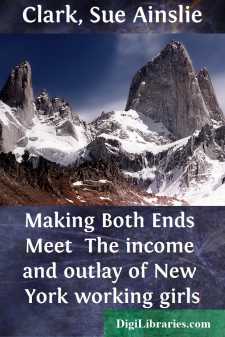Categories
- Antiques & Collectibles 13
- Architecture 36
- Art 48
- Bibles 22
- Biography & Autobiography 813
- Body, Mind & Spirit 142
- Business & Economics 28
- Children's Books 17
- Children's Fiction 14
- Computers 4
- Cooking 94
- Crafts & Hobbies 4
- Drama 346
- Education 46
- Family & Relationships 57
- Fiction 11829
- Games 19
- Gardening 17
- Health & Fitness 34
- History 1377
- House & Home 1
- Humor 147
- Juvenile Fiction 1873
- Juvenile Nonfiction 202
- Language Arts & Disciplines 88
- Law 16
- Literary Collections 686
- Literary Criticism 179
- Mathematics 13
- Medical 41
- Music 40
- Nature 179
- Non-Classifiable 1768
- Performing Arts 7
- Periodicals 1453
- Philosophy 64
- Photography 2
- Poetry 896
- Political Science 203
- Psychology 42
- Reference 154
- Religion 513
- Science 126
- Self-Help 84
- Social Science 81
- Sports & Recreation 34
- Study Aids 3
- Technology & Engineering 59
- Transportation 23
- Travel 463
- True Crime 29
Making Both Ends Meet The income and outlay of New York working girls
Categories:
Description:
Excerpt
CHAPTER I
THE INCOME AND OUTLAY OF SOME NEW YORK SALESWOMEN
One of the most significant features of the common history of this generation is the fact that nearly six million women are now gainfully employed in this country. From time immemorial, women have, indeed, worked, so that it is not quite as if an entire sex, living at ease at home heretofore, had suddenly been thrown into an unwonted activity, as many quoters of the census seem to believe. For the domestic labor in which women have always engaged may be as severe and prolonged as commercial labor. But not until recently have women been employed in multitudes for wages, under many of the same conditions as men, irrespective of the fact that their powers are different by nature from those of men, and should, in reason, for themselves, for their children, and for every one, indeed, be conserved by different industrial regulations.
What, then, are the fortunes of some of these multitudes of women gainfully employed? What do they give in their work? What do they get from it? Clearly ascertained information on those points has been meagre.
About two years ago the National Consumers' League, through the initiative of its Secretary, Mrs. Florence Kelley, started an inquiry on the subject of the standard of living among self-supporting women workers in many fields, away from home in New York. Among these workers were saleswomen, waist-makers, hat makers, cloak finishers, textile workers in silk, hosiery, and carpets, tobacco workers, machine tenders, packers of candy, drugs, biscuits, and olives, laundry workers, hand embroiderers, milliners, and dressmakers.
The Consumers' League had printed for this purpose a series of questions arranged in two parts. The first part covered the character of each girl's work—the nature of her occupation, wages, hours, overtime work, overtime compensation, fines, and idleness. The second part of the questions dealt with the worker's expenses—her outlay for shelter, food, clothing, rest and recreation, and her effort to maintain her strength and energy. In this way the League's inquiry on income and outlay was so arranged as to ascertain, not only the worker's gain and expense in money, but, as far as possible, her gain and expense in health and vitality. The inquiry was conducted for a year and a half by Mrs. Sue Ainslie Clark.
The account of the income and outlay of self-supporting women away from home in New York may be divided, for purposes of record, into the chronicles of saleswomen, shirt-waist makers, women workers whose industry involves tension, such as machine operatives, and women workers whose industry involves a considerable outlay of muscular strength, such as laundry workers.
Among these the narrative of the trade fortunes of some New York saleswomen is placed first. Mrs. Clark's inquiry concerning the income and outlay of saleswomen has been supplemented by portions of the records of another investigator for the League, Miss Marjorie Johnson, who worked in one of the department stores during the Christmas rush of 1909-1910....


